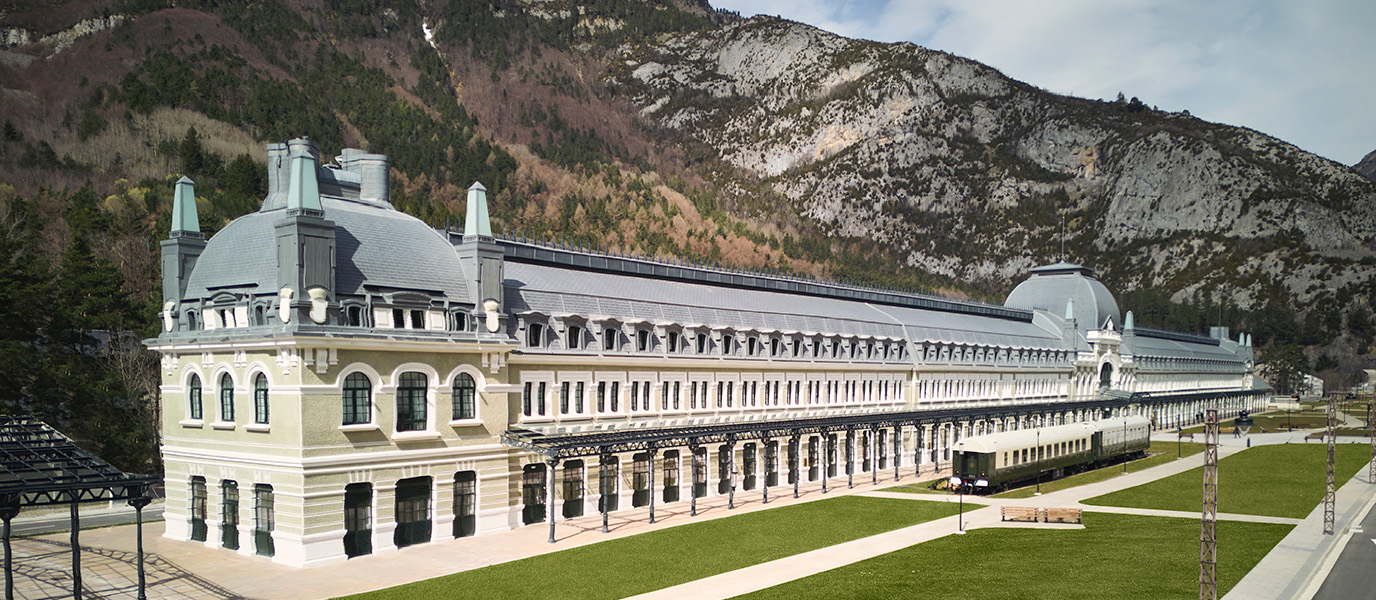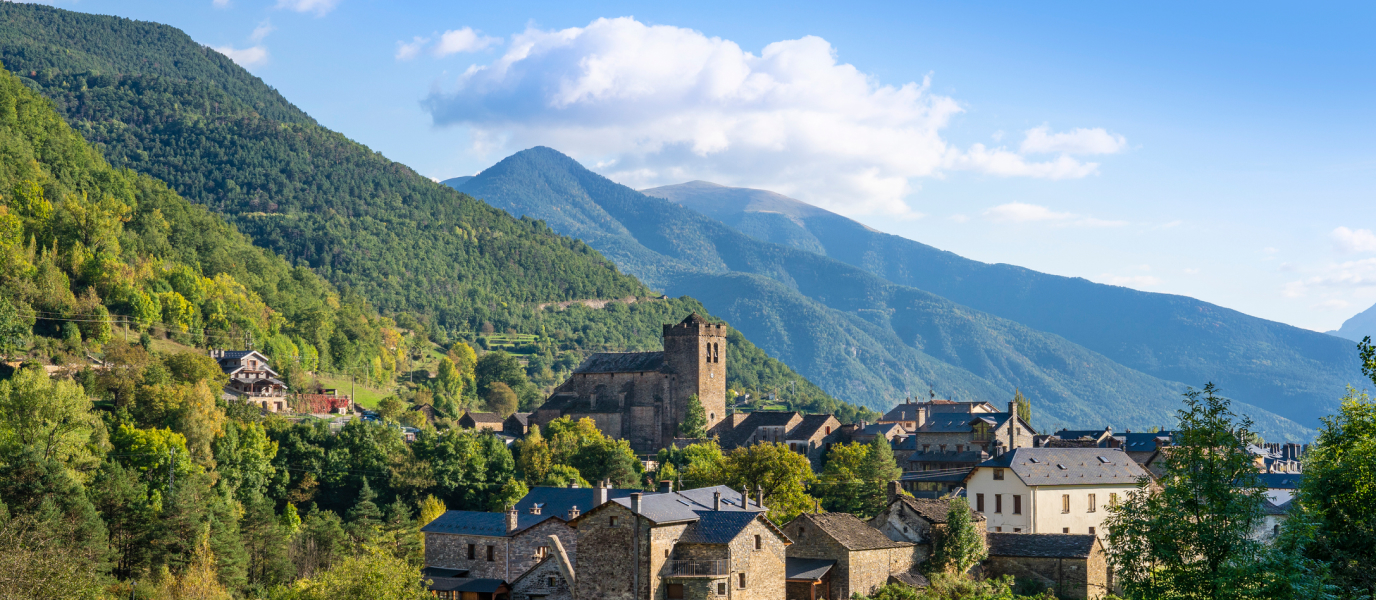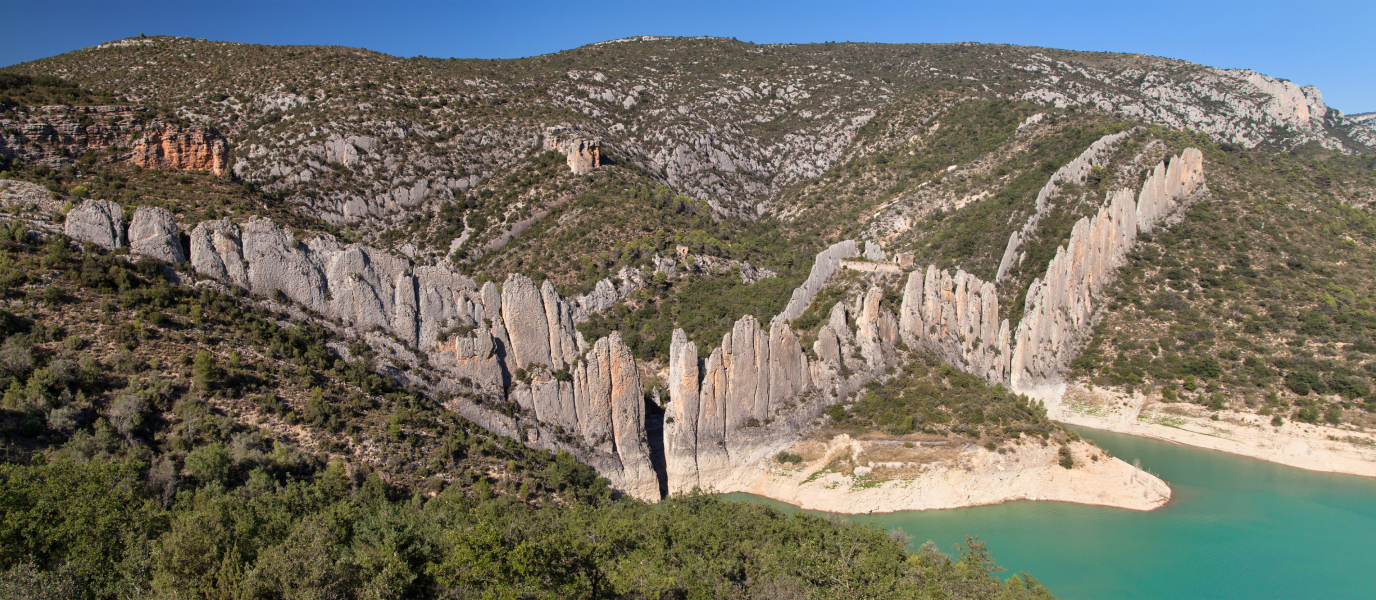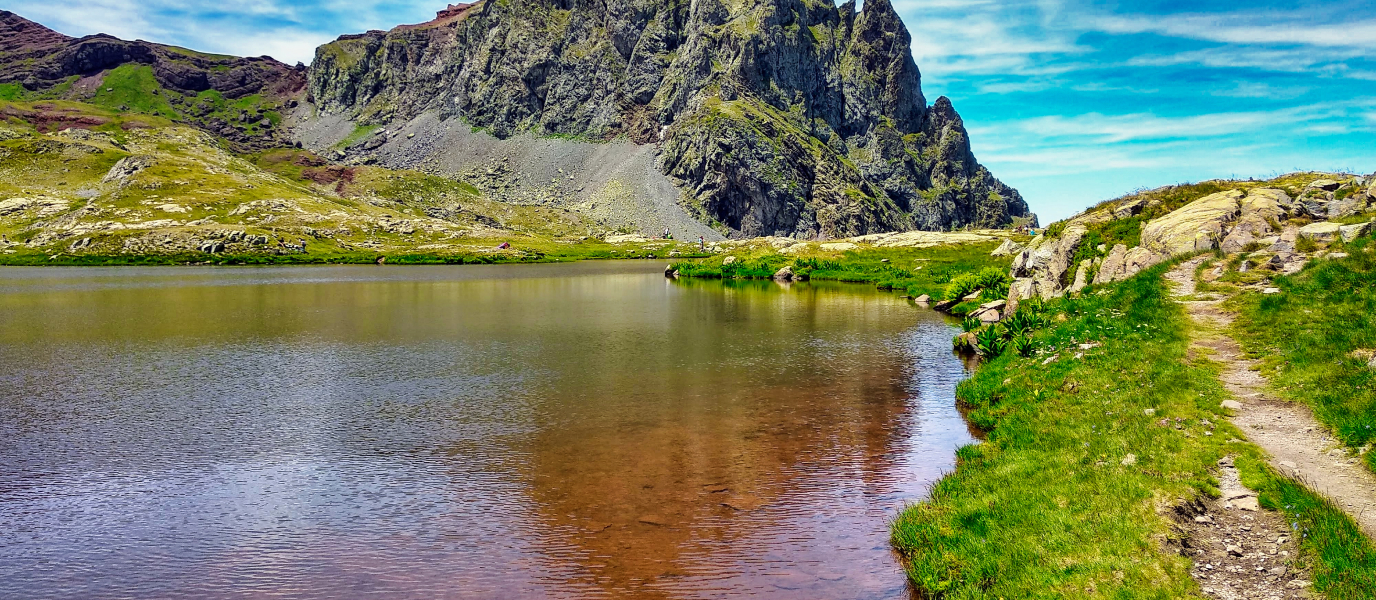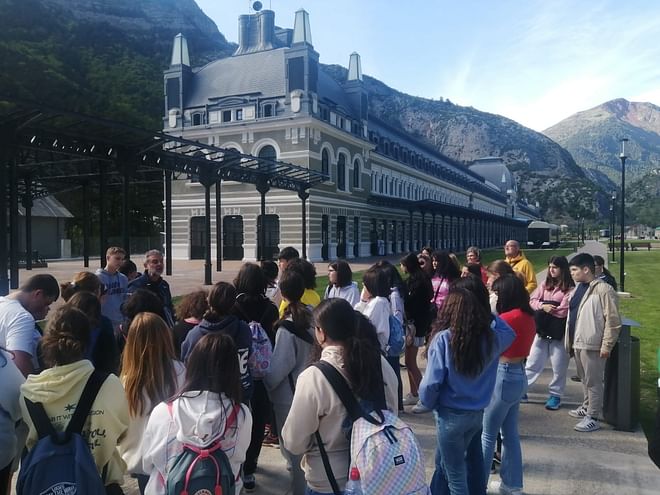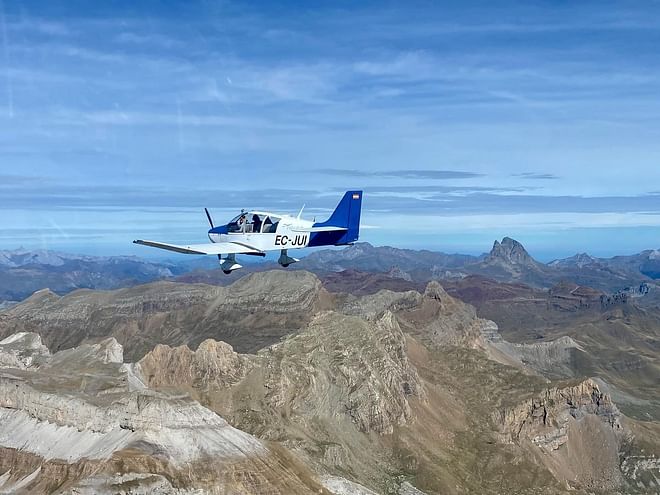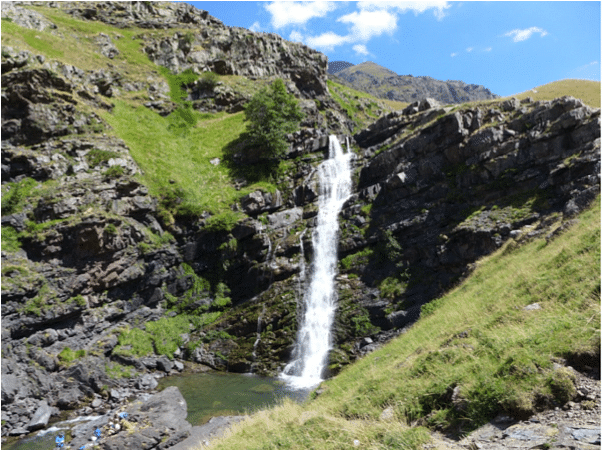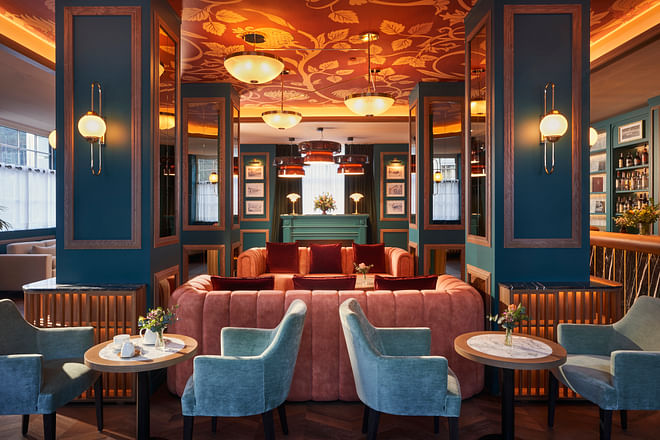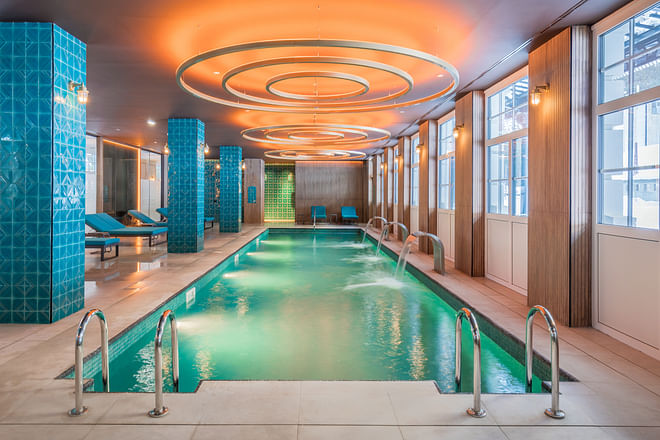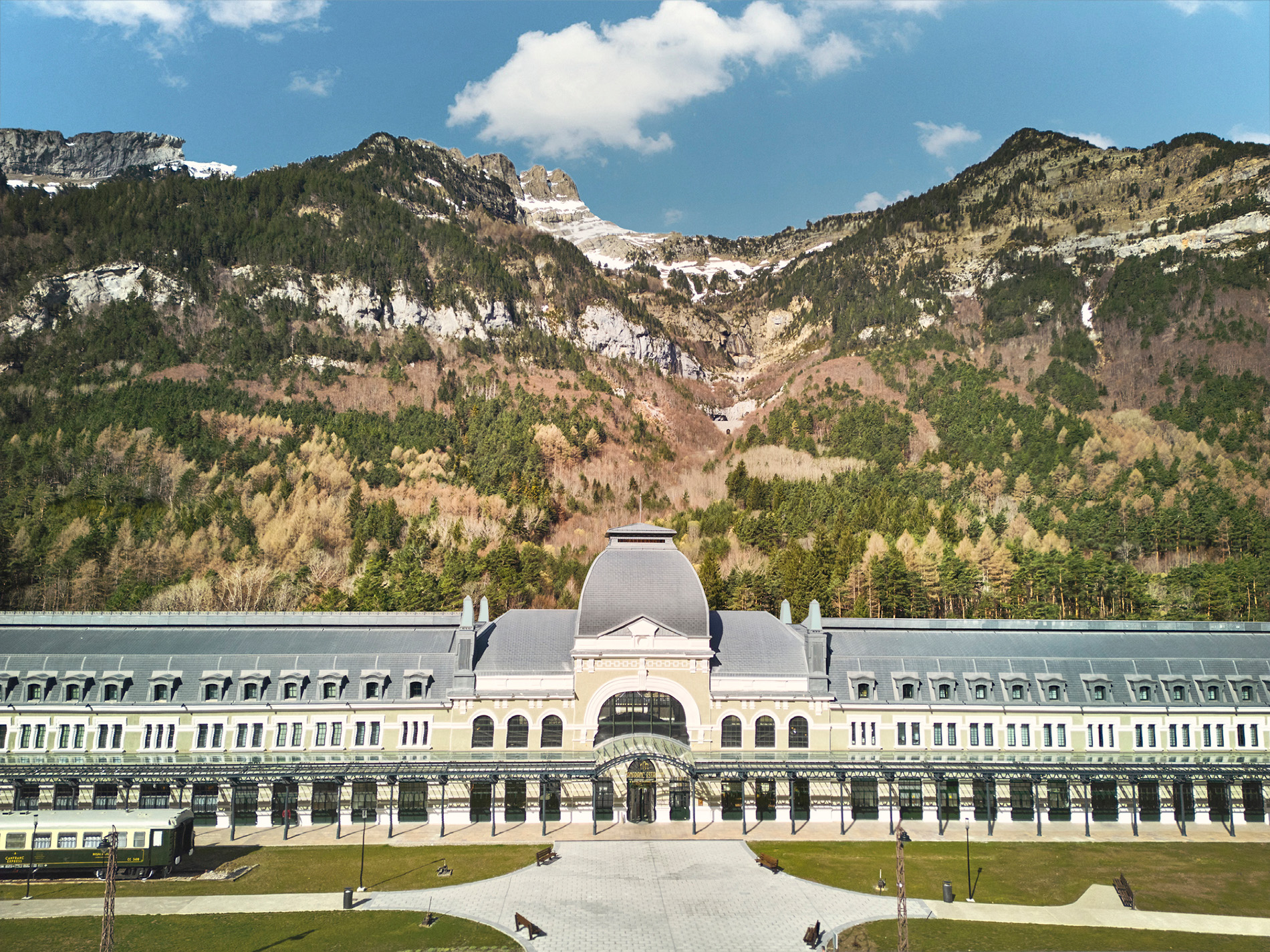The year 2023 marked a milestone in the history of Barceló Hotel Group with the opening of Canfranc Estación, a Royal Hideaway Hotel. This was an event linked to artistic heritage, history, culture, luxury, and the whole travelling experience. Because this beautiful, iconic and almost a-hundred-year-old railway station in Aragon, which has seen so many trains and travellers pass along its platforms, had been converted into one of Barceló Group’s insignia hotels.
This is a truly remarkable establishment and an extraordinary experience in an emblematic spot — the valley of Canfranc, in Huesca.
- The history of Canfranc Station A unique spot
- Guided tours of Canfranc station
- What to see in Canfranc
- Why you should stay at the new Canfranc Estación, a Royal Hideaway Hotel
- Spa & Wellness
- What to see and do on your holiday in Huesca
The Canfranc Estación, a Royal Hideaway Hotel, aims to become the Aragon Pyrenees’ emblem of luxury and wellness through an exclusive and unforgettable experience linked with the railway history in an exotic location that has no establishments to compare with the Canfranc Estación.
Opened in 1928 and declared an Asset of Cultural Interest in 2002, Canfranc’s railway station has been the scene of important historic events and now, with its conversion into a luxury hotel, aims to open a new chapter linked to the twenty-first century and to its historic legacy. The objective is to honour the building’s legacy, but from a modern perspective.
The monumental, majestic Estación de Canfranc is not just any hotel, but a sanctuary for the discerning traveller who loves unique and ground-breaking experiences based in nature, wellness, haute cuisine and beauty.
With the opening of this hotel, Barceló Hotel Group is consolidating its position in Aragon, where it has been present since 2005 with the Barceló Monasterio de Boltaña, a former monastery converted into a luxury hotel.
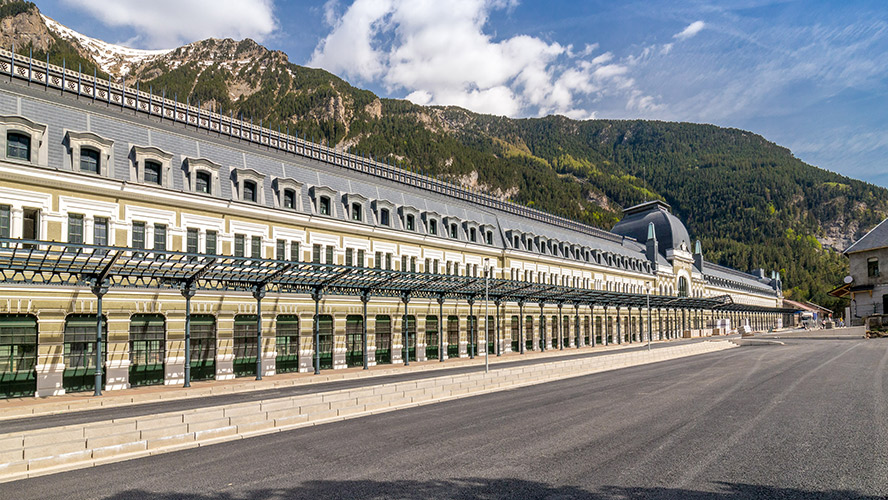
The history of Canfranc Station A unique spot
The international station of Canfranc is closely related to the rail link between Spain and France. The Somport border tunnel linked the two countries of the Pyrenees. This brought new possibilities for moving passengers and goods.
The idea behind this project first arose in 1853, in a call for the construction of a line from Madrid-Paris via the Aragonese Pyrenees. Eleven years afterwards, the first studies began. It was recommended that the line should pass through Saragossa and the French town of Pau.
Works on the Somport tunnel (a crucial section of the project) were carried out between 1908 and 1912. However, it was not until 1928 when Canfranc station was inaugurated, with the king Alfonso XIII and the French president Gaston Doumergue presiding.
Nazi gold in exchange for Galician tungsten in Canfranc
In the Spanish Civil War, the nationalists closed the Somport tunnel to prevent any raids from France. However, some of the best stories about the station happened during the Second World War.

With the French side under the control of the Nazi army, trains bringing tungsten from Galicia travelled through Canfranc en route to Germany’s armaments factories. Franco repaid the help Hitler gave him during the Spanish Civil War. Conversely, trains laden with gold entered Spain originating from Germany. Most Nazi gold would keep moving until reaching Portugal. The station and customs post at Canfranc station were controlled by the Gestapo.
After the war, the Canfranc station would never regain its former glory. Activity at what was then the second largest station in Europe would decline and grind to a halt. This occurred with the end of the international link between Spain and France at Canfranc, caused by the collapse of the L’Estanguet bridge in 1970 on the French side in suspicious circumstances.
An international station
The main feature of the Canfranc station is its international nature. As tracks in Spain have a different gauge (the Iberian gauge is1668 millimetres as opposed to 1435 for the European gauge), this meant there had to be two marshalling yards, one for each side of the building, with their respective duplicated platforms, entrances, and internal services for the station.
Both the passengers and the goods had to change from one side to the other if they wished to continue their journey between both countries. Freight was stored in hangars, and there were exchange points with cranes and mixed tracks, so that trains from both countries could run. Passengers, however, were confined to one or other of the platforms (the French platform to the east or the Spanish platform to the west), and passed from one country to the other through the inside of the station building. The building provided the same services on each side for each country, including ticket offices, a currency exchange office, customs, police station, post office, hotel, and so on.

This explains the size of the Canfranc station: 241 metres long, 12 metres wide, and with 424 windows and 150 doors. The impressive length of this authentic rail frontier on Spanish soil only adds to its visual impact.
On first sight, the Canfranc station is reminiscent of the style so frequently used in French stations. This can also be seen in buildings such as the current Museé d´Orsay (The Orsay Museum) in Paris with a slate roof, dormer windows, art-deco pinnacles and a large central dome. Given its length, the building is narrow: this is because it was designed so that there would be sufficient space for the two sets of tracks that were needed on each side.
Visits to the Canfranc station
Despite being abandoned for decades, the Canfranc station has always been a great attraction for tourists and railway enthusiasts. On being restored for future hotel projects, the area has been revitalised. This has raised interest in finding out about the past behind this magical building.
Guided and dramatised tours of the station
The hotel organises guided tours of the railway station. Due to the limited space and the high demand, tickets must be booked via our website.
The guided tour of Canfranc station takes approximately an hour and a half; tours are in Spanish, English and French, and end in the lobby.
The dramatised tour takes about two-and-a-half hours. On these tours, visitors are led through the area around the station and through a nearby wood by a guide dressed as a character from that period.
What to see in Canfranc
The initiative to create a rail link between Spain and France through Somport meant that a new town had to be built around the future station, in the area of Los Arañones. This is what is now known as Canfranc-Estación, which lies four kilometres to the north of the original village of Canfranc. Here we can see 20 buildings that were once dwellings, a pharmacy, and a doctor’s surgery, or were used to provide other services for the families who lived there. Nowadays, they are brightly painted, and offer very similar services to the local population and to visitors.
Almost four kilometres to the south lies the former village of Canfranc, a village of just one street. From the year 1000 onwards, the people of this village protected the border, housed and defended the customs post and the royal frontier, and kept the area clean and safe. They had been granted rights of ‘rota y porta’, which meant that they could levy tolls and taxes on any goods that passed along the street in either direction.
Thus, Canfranc boasts a significant historic heritage. For example, there is the beautiful Fusilier Armoured Lookout Tower (nineteenth century) which may have contained a contingent of 25 men who guarded access to the Aragon Valley.
There are also various ‘P Line’ bunkers, constructed by the Franco regime out of fear of the activities of the Maquis (resistance fighters who refused to accept defeat after the end of the Civil War), or of a possible invasion from France. These military buildings (which were never used) have been partly renovated and are open to the public. As we shall see later, visitors can explore them by following the so-called Trail of the Bunkers.
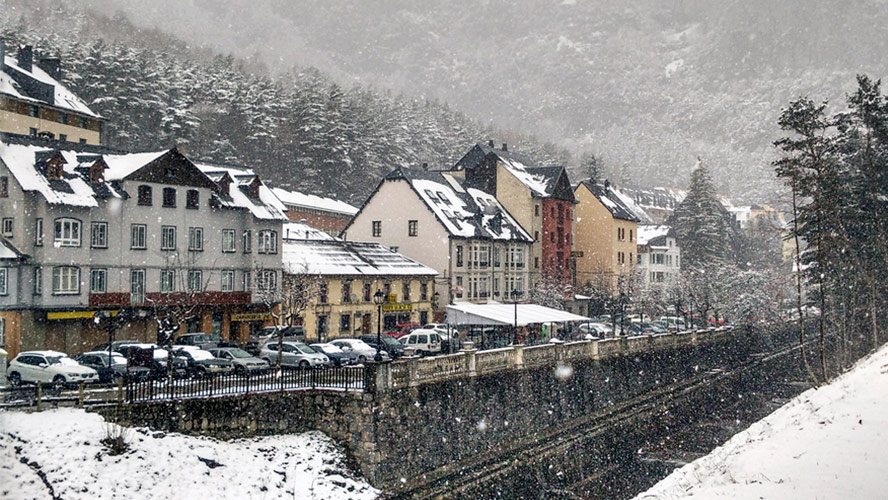
Without question, Canfranc is the gateway to one of the most popular skiing areas in the Spanish Pyrenees, with the ski stations of Astún and Candanchú located just a few kilometres away. Hordes of skiing enthusiasts gather in Canfranc to travel up to these two resorts, each of which boasts 50 kilometres of ski slopes, giving a total skiable distance of 100 km.
Moreover, France is on the other side. The area is easily reached via the Port of Somport or using the modern Somport tunnel, which provides a convenient and fast road link with the neighbouring country.
Now we will tell you what you really must visit in Canfranc:
A walk around the town of Canfranc
It is worth taking a leisurely walk around the heart of the old town of Canfranc. The town lies on the Camino de Santiago [Way of St. James], and was founded in the eleventh century in a valley with few agricultural resources. This forced the inhabitants to devote themselves to trading and to providing hospitality for pilgrims and travellers. Don’t forget to visit the remains of the sixteenth-century church of Trinidad; the fourteenth-century fortified house of the lesser nobleman Aznar Palacín, located right by the river Aragon; the stone-built sixteenth-century pilgrims’ bridge, and what is left of the castle.
Trail of the Bunkers
This strange, interesting itinerary covers a series of bunkers built with the aim of defending the population from a possible invasion from France — that never actually occurred. These are military shelters built between 1944 and 1959. During this period, hundreds of bunkers were built throughout the Pyrenees, from the Cantabrian Sea to the Mediterranean Sea. Some say that there are 4,000 fortified installations in total. Known as the ‘P Line’ or ‘Pyrenees Line’, this was possibly the biggest fortification project undertaken in Europe after the Second World War.
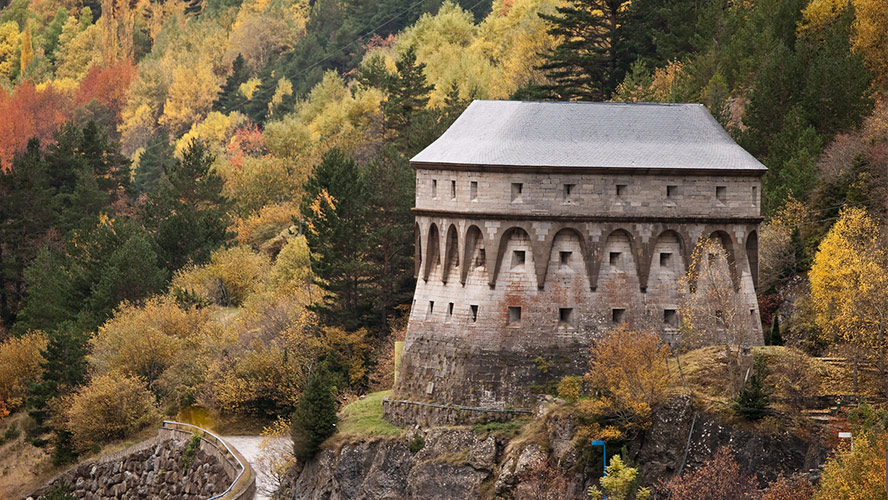
Torreta de Fusileros [Fusiliers’ Tower]
Dating from 1876, this intriguing fortification was built following the completion of the road that connects Zaragoza with France via Somport. It was planned to defend this important line of communication with a huge fusiliers’ tower that could house a contingent of up to 25 men. The building contained one room for the officers, with others for the sick bay, the prison and the woodshed. The Torreta de Fusileros has an unusual, elliptical floor plan, a perimeter moat that could be crossed via a drawbridge, and four storeys built around a large central courtyard.
Coll de Ladrones Fort
A defensive fort built in 1751, which has since been occupied on and off by soldiers, batteries of cannons, and other defence systems to protect against invasion by the French. A full gallery of stairways was dug out of the rock, virtually as far as the river, serving both as a line of defence (as weapons could be fired from its narrow windows) and as a means of escape if the tower was captured. Although the interior is in a reasonable state of preservation, visitors are currently only allowed to view the outside of the fort.
Church of Nuestra Señora del Pilar
Designed by Miguel Fisac en 1965 and consecrated on the 14th of December 1969, the architecture of this little jewel of the Modern Movement masterfully embodies the trends which arose following the Second Vatican Council — characterised by compositional rationality, functionality, and a rejection of ornamentation. For this reason, the church was declared an Asset of Cultural Interest under Decree 257/2007 by the Government of Aragon.
Where to eat, and what to eat in Canfranc
The typical cuisine of Canfranc is based on natural ingredients that are the basis of its excellent traditional recipes. The area is famous for its game, meat stews, and dishes incorporating fried breadcrumbs. All washed down with good Somontano wines.
Canfranc has lots of good restaurants. Here are a few suggestions:
- Laduanilla Canfranc. With its thoughtful, traditional décor, this is a small but very welcoming restaurant, with an attractive terrace available in good weather. Don’t miss the wild mushroom croquettes, the salad with fried egg, or the scrambled egg with mushrooms.
- Borda l’Anglassé. The menu offers a good range of typical Aragonese dishes. There is something here for everyone: creative cooking, a set menu, à la carte, food for coeliacs, vegan food, and more. Everything is on display and you’ll be spoilt for choice. All the food looks highly tempting. You can choose anything from slow-cooked Iberico pork cheek to a millet burger with melted cheddar cheese and caramelised onion.
- La Brasa Asador. This restaurant specialises in meat dishes (although there other options), and everything is home made. It offers excellent value for money. You can also make your choice from the daily set menu. Servings are generous, and all the food is good: the squid, the green beans with potatoes, the patatas bravas… Booking in advance is recommended.
- Restaurante Ara. This establishment serves excellent set menus and offers exceptional views of the mountain. At this restaurant, they prepare paellas and other dishes to order for groups of family or friends. Very attentive service.
- Restaurante Universo. This is the area’s oldest restaurant. It is also the restaurant with the biggest terrace. You can call in at any time of the day and well into the evening: to have breakfast, lunch, dinner, and even supper. It offers a varied cuisine, attentive service and very reasonable prices.
- Cafetería El Andén. This is an excellent place to enjoy a sweet or savoury breakfast, with toast topped with avocado or various cheeses. At lunchtime, they serve, for example, a delicious potato omelette with bread spread with tomato. Moreover, the terrace is right opposite the station.
- Finally, La Pizzería, Kilómetro 666 and Bar Flores are also good alternatives to sit for a while and enjoy a good tapa, an informal dinner, or local and international dishes.
Why you should stay at the new Canfranc Estación, a Royal Hideaway Hotel
A stay at the Canfranc Estación, a Royal Hideaway Hotel is an unforgettable experience that will take you on a journey back through time to become part of Spanish railway history, while enjoying the contemporary, ground-breaking style and all the comforts of a 5-star, grand luxe hotel. The project to adapt and remodel the old railway station went to great pains to respect the DNA of the original building while it was being transformed into an emblem for the twenty-first century.

Canfranc Estación, a Royal Hideaway Hotel has 104 guest rooms designed, like the rest of the hotel, by the Il Mio Design interior design team. It has welcoming and elegant spaces that co-exist in harmony with art deco elements to create an ambience that is at the same time both nostalgic and modern. To achieve this, the designers have used high-quality materials such as wood and brass, rich textures such as velvet, and a 1920s-inspired colour scheme. Four of the guest rooms are luxury suites with space for up to 10 people.
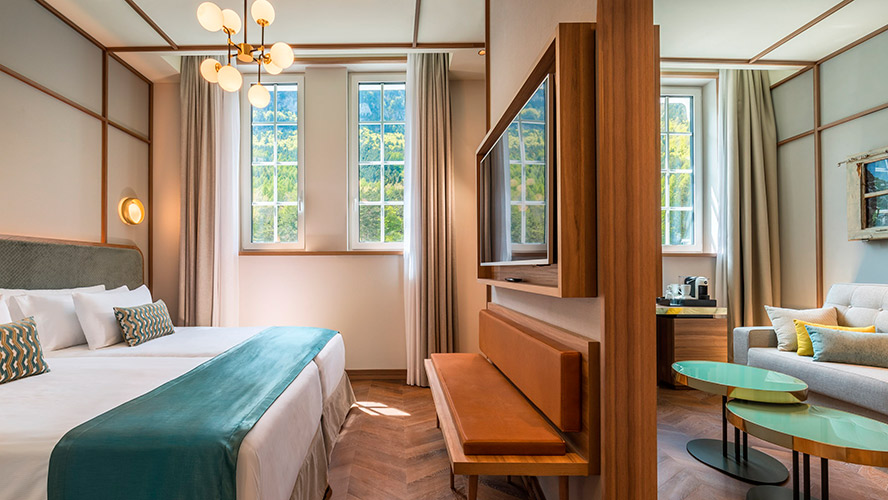
Spa & Wellness
On the hotel’s ground floor is the Wellness Spa, covering over 420 m2, with a heated swimming pool and a fitness area — as well as a library where you can enjoy a drink from the exclusive cocktail bar. What was once the station’s vestibule is now the hotel’s reception area.
Temperature-regulated swimming pool. Guests have access to the hotel’s heated swimming pool where they can relax in the water and benefit from the swan-neck jets and the shower circuit.
Treatment rooms. There are four treatment rooms where guests can enjoy various experiences designed to restore body and mind. The Spa offers special massages, facial treatments, body therapies, and reflexology sessions.
Fitness zone. In addition to a gymnasium with a full range of equipment, there is a 200 m2 water area.
Gastronomy. The hotel’s restaurants. One of the features of this exceptional hotel in the Aragon Pyrenees is its amazing gastronomy, based on the offer of haute cuisine and headed up by two of the Aragon culinary scene’s leading lights: Eduardo Salanova and Ana Acín, the chef and head waiter respectively. The gastronomic offer includes three restaurants, two bars and a library specialising in creative cuisine with a nod towards tradition. These gastronomic restaurants are of course à la carte, and are housed in two restored railway carriages located outside the main building. They are the Canfranc Express and 1928. This offer is complemented by the El Internacional restaurant and the spacious Art Deco Lobby Bar, on the ground floor of the hotel.
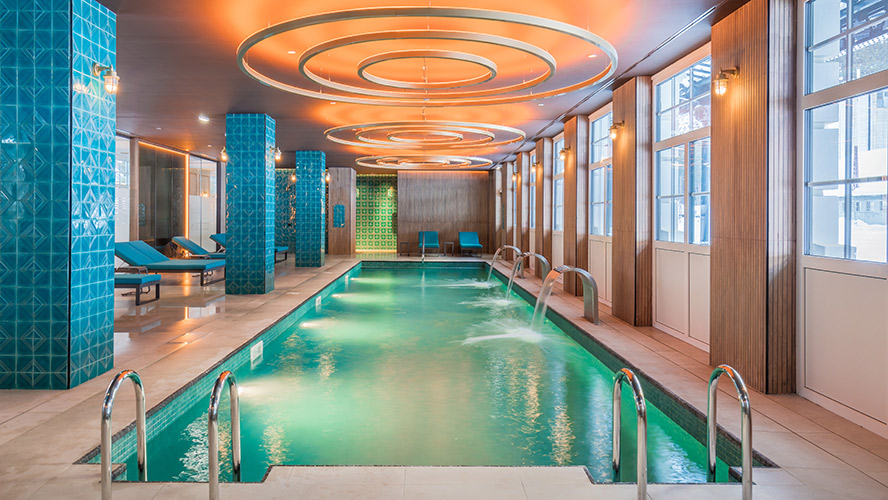
More to see and do on your holiday in Huesca
Natural scenery Canfranc Station is set amid exotic and beautiful scenery, offering a plethora of possibilities for discovering idyllic spots. You could, for example, make your way to the El Juncural Ecopark in Villanúa. Or you could follow the ‘P Line’ Bunkers Trail to explore the defensive structures built between 1944 and 1959 to protect against a possible military invasion from France, which never materialised. Or you could walk the stretch of the French Camino de Santiago (Way of St. James) that links Canfranc Station with the town of Canfranc and, en route, you could see the Torreta de Fusileros and the Arriba bridge, which dates back to medieval times.
The prettiest towns. There are pretty towns in the area around the hotel. It is worth taking a walk to the town of Canfranc, about 3 kilometres from the railway station. The town lies on the Camino de Santiago, and was founded in the eleventh century in a beautiful valley with a rich historic heritage. We would also recommend a visit to Jaca, a city of medieval origins with an attractive historic centre. Or you could explore the beautiful village of Boltaña, where you can journey back though time and immerse yourself in the remarkable Colegiata de San Pedro, built in the fourteenth century.
The Historical Heritage. You will find valuable and important examples of the historic heritage in the area around Canfranc Station. Examples are the former Hospital de Santa Cristina de Somport, the Monastery of San Adrián de Sasabe, the Cathedral of San Pedro de Jaca and the Monastery of San Juan de la Peña — not forgetting the Coll de Ladrones de Canfranc, and the Castle of San Pedro in Jaca, more commonly known as La Ciudadela.
Ski resorts. If you are visiting during the winter, you could go hiking with snow shoes or try alpine and Nordic skiing at the Astún, Candanchú and Somport ski stations. These destinations are much sought after by winter sports enthusiasts. But whatever time of the year you visit will have its particular charm, and you are sure to enjoy this superb setting.
























































